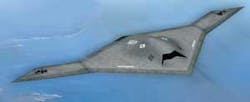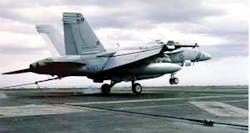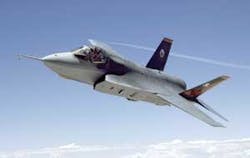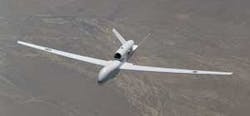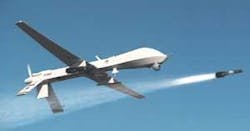The military, once again, is the technology leader when it comes to the aviation electronics of unmanned aerial vehicles, which is growing in sophistication with each passing year and leading many experts to consider applying UAV avionics technologies even to manned aircraft.
By J.R. Wilson
The stunning success of the military’s latest generation of unmanned aerial vehicles (UAVs) and an upsurge in development of new platforms for information, surveillance, and reconnaissance (ISR)-as well as armed attack-missions has led to some significant advances in small-scale avionics systems.
Now the supporting technologies for this once-maligned platform may well influence the design and operation of future avionics systems for manned aircraft and even the civil air traffic control system (ATS).
“We did a study for the FAA [Federal Aviation Administration] at least a decade ago on what is the safest kind of ATS,” says Mark Krumm, senior business development manager for the Harris Corp. Government Communications Systems Division in Melbourne, Fla. “Nobody liked the result because the best one would have no humans in it-100 percent machine-controlled with all the human error removed.”
Sentiment today, however, has changed. “If you bring that forward a decade to where we have UAVs that can take off and fly a mission by themselves, return to base, and land autonomously, you might be able to translate that to having an aircraft with no pilot,” Krumm says. “Basically, machines are more reliable than humans, although a human pilot is the best when it hits the fan.”
The aviation industry today is seeing improved capability at a lower price, largely due to the availability of commercial off-the-shelf (COTS) memory and processors. “You have a lot of data on these aircraft, so you have very powerful, very large computers and processors being developed,” Krumm says. “Once that is developed for UAVs, it will be available for civil aviation, as well. That is not just a trickle; it’s a flood.”
Military a driving force
In reality, the large and powerful computers and processors Krumm refers to are not large in a physical sense, but becoming increasingly small and lightweight, even as capability improves dramatically. It is, in fact, now one of the few areas in the entire computer industry where the military is, once again, a driving force.
This hard push from the military comes from the successes UAVs have had in Southwest Asia and from other combat zones in the global war on terrorism. While the U.S. Department of Defense (DOD) remains committed to COTS-based development wherever possible, the urgency of the current wartime effort has resurrected DOD as a major player in the underlying development of what will become COTS-and has spurred industry to cooperate.
“The commercial world is squeezing every nickel they can out of its product and every bit out of its bandwidth. The military has a different mindset; they want something with 100 percent reliability that will still work if you drop it,” Krumm says.
“The military also is looking at doing more and more communications with less bandwidth. For example, cognizant radio constantly samples the environment it is in-what frequencies are being used or not used-and reshaping its own comm methods by using what is available. That is a different way of sharing the frequency environment, which currently is very rigid-you will operate within this bandwidth and nothing else-with no leeway to use idle bandwidth assigned to someone else. So that would be a sweeping change for the military that, once solved, would immediately spill over to the civil world.”
That same new military approach is being applied to processors that, in the past, have been custom-built for specific applications, such as radar or communications integration. Instead, the military today is demanding COTS-based processors that not only provide more MIPs per dollar, but also are truly general purpose so they can be easily reconfigured to any task.
“Current data-link technologies basically consist of a handful of approved data links-TCDL, ATRS, MIDS-all of which are frightfully expensive,” Krumm says. “Meanwhile, the commercial world is developing very high-bandwidth, low- cost 802.11-based gear that we are now being asked to adapt for use on military aircraft.” This cycle cannot go on forever, Krumm warns.
“Soon the bubble is bound to burst. You can have a mandated mil-spec radio at a very high price, or you can-for about one-tenth the price-have a COTS-based system,” Krumm says. That is where the circle finally completes itself, with the unique military application of a COTS system being seen as a worthwhile advancement for civilian applications.
Civil applications of mil COTS
“All UAVs struggle with one common problem-they have wide-bandwidth SAT COM on the run, which is currently really expensive, using electronically scanned arrays rather than dishes,” Krumm says. “So we will see a lot of money poured into electronically scanned SATCOM antennas-and once the military spends the huge development costs for those, I think they will find a home on commercial aircraft. If you look at the more mundane air traffic, such as freighters, you could build unmanned aircraft that could fly at the most economical cruise (speed).”
Such military developments could even find their way into the current civil ATC system, where civil authorities worldwide have been searching for ways to reduce the separation between aircraft to allow more flights per day to the same location, as well as to allow the airlines to pick their own, most direct and/or economical, routes from departure to destination. This “Free Flight” environment is no pipedream but a serious effort by the international ATC community to solve rapidly growing, multilevel airspace congestion.
UAV developments, especially those being pursued by the unmanned combat air vehicle (UCAV) community, also could influence manned military aircraft in the future and even, with some modification, commercial aircraft and ATC systems.
“There are a lot of parallels (between UAVs and piloted aircraft). If you parse through the mission JUCAVs (Joint UCAVs) are trying to do, they are looking at as much single-platform operation as possible, precision targeting without a lot of cuing,” Krumm says. “If you were able to build a hands-off, no man-in-the-loop target location system for JUCAVs and could get weapon coordinates for the small-diameter bomb-which is what the military is trying to do-then you would have a best-seller for manned aircraft. You could take the F/A-18 or F-22, which need a lot of off-board cuing, and help to develop that same confidence in target location. So if JUCAVs can develop that technology, it would go right into those manned fighters.
“JUCAV is also trying for unprecedented levels of stealth, which, if achieved, the manned aircraft guys will be right behind them,” Krumm continues. “There are avionics issues involved there, as well. There are innovative radar concepts being looked at for ultrastealthy platforms; pull those off and they will also go right to manned aircraft. Another thing is architecture. If you are trying to maintain a stealthy posture, you have a whole series of trades to consider: how much of this equipment is on your aircraft and compromises your location by using energy or do you use another architecture where someone else does the emitting and you just have a receiver. That is bistatic radar, although I don’t know whether anyone has ever done it successfully. But if they can pull it off on JUCAVs, it can be used anywhere.”
UAV avionics for manned aircraft
As part of the Lockheed Martin F-35 Joint Strike Fighter (JSF) team, Harris will develop a new avionics infrastructure, image-processing and digital-map software, fiber-optic physical-layer components and interconnects, high-speed communications data links, and other components such as power supplies, RF backplanes, and portions of the Communications Navigation & Information (CNI) system. All are critical to a more efficient, high-capacity, and affordable avionics capability than has gone into any previous aircraft.
The Pentagon’s mandate for JSF is perhaps the most rigorous ever applied to any new manned combat aircraft: a sophisticated, survivable, stealthy weapon system that will meet several military service performance requirements for decades, while achieving strict affordability targets. Unfortunately, officials of the Lockheed Martin Skunk Works, responsible for developing and adapting new technologies to company programs, consider work in UAV-commercial avionics crossover to be too proprietary at the moment to contribute to this article.
At the Boeing Phantom Works in St. Louis, however, Patrick Stokes, program manager for Network Centric Operations Thrust for contractor R&D, and Dr. James L. Paunicka, associate technical fellow and principal investigator on program composition of embedded systems (PCES) and software-enabled control (SEC), freely discussed their work on two related Defense Advanced Research Projects Agency (DARPA) programs.
In a recent joint military exercise at White Sands Missile Range, N.M., a Boeing Scan Eagle UAV demonstrated the ability of PCES software to enable a UAV in the field to autonomously map its own path without operator input, a Boeing spokesman says, while another recent flight test at Victorville, Calif., used a DARPA Renegade rotorcraft UAV to demonstrate the ability of SEC software to assume control of the UAV using autonomous control algorithms based on Boeing’s Open Control Platform (OCP) architecture. SEC flight tests have also used a Boeing F-15E jet fighter-bomber and a Lockheed T-33 jet trainer. Boeing is also working to develop common mission management software that would enable different UAVs to operate effectively within the same network.
“Both of these programs are centered around adding autonomy to unmanned systems, although the idea of transferring some of this technology to manned aircraft has been discussed,” Stokes says. “In general, you could argue a lot of the automatic features-aggressive maneuvering, landing, etc.-we tested could be implemented in situations that would relieve pilot workload. Nor would it be much of a stretch to use some of these applications with tilt-wing or tilt-rotor aircraft. When we did the SEC fixed-wing demonstrations, we addressed some of those areas, including carrier-based landings in the air with a T-33 playing the role of carrier. We also did formation flight experiments, with a manned fighter taking the lead and a UAV maintaining station.”
Avionics software
With software constituting a major part of the cost of avionics, he notes, DARPA has invested more than $100 million to improve SEC and PCES. As that effort has evolved and matured, Boeing began looking at using C++ and Java-based software to provide better flight platform integration. A major accomplishment has been generating a new component model for embedded avionics software that helps define how applications components are connected and then implemented on UAVs or manned flight platforms. Hosting the same software on several platforms reduces the costs of development and implementation.
Boeing’s C++ architecture-Product line Reusable Scalable embedded (PRiSm) component model-is to enable the rapid rehosting of common avionics software across several product lines. Such an architecture must be scalable, to support both very small and extremely large applications, such as mission-processing applications using several onboard embedded computers on fighter aircraft and large UAVs, such as Global Hawk. Another embedded software architecture developed for PCES uses real-time Java, leading to a component model called PriSm-J.
“Most of our programs feature a live flight demonstration to prove to DARPA that all of these research ideas can actually be implemented in real platforms and fit within the constraints of embedded platforms (memory, speed, etc.), as well as work across real-world data links,” Paunicka explains. “Our big live program was called the Capstone Demonstration on April 14 at White Sands, where we had observers from all the services and DARPA.”
UAVs and real-time JAVA
“We showed how embedded software technology from PCES helped enable the Scan Eagle UAV to prosecute time-critical targets,” Paunicka says. “In particular, we integrated autonomy algorithms onto two Scan Eagles, using it to route the vehicle to help an air ops commander find targets, provide monitoring of live weapons strikes, and to guide the UAV back over an area struck by weapons to provide battle damage imagery. One of the Scan Eagles used our C++ software, the other real-time Java. We believe this was the first flight of real-time Java in guiding a UAV.”
The Scan Eagle was chosen for the integration tests because of its payload processor-a COTS PC/104 board available from a variety of vendors-and a slot in the UAV’s avionics box that can be used to rapidly integrate mission-specific capabilities. Using an application programming interface developed in collaboration with the Insitu Group in Bingen, Wash., the Phantom Works team integrated sufficient autonomy to enable the Scan Eagles to move around the simulated White Sands battlespace, participating in all elements of the kill chain-find, fix, target, track, engage, and assess.
“The scenario had separate roles for each UAV-one for recon, the other tracking,” Stokes says. “During the scenario, we surveiled a suspected terrorist meeting place (an old trailer parked in the desert). After it was hit by an Army TACOM live-fire missile, the UAV doing BDA (battle damage assessment) picked up a vehicle approaching the site and then fleeing. The commander then assigned the second UAV to track the vehicle to a second trailer elsewhere in the desert. We then engaged that second target with a JDAM dropped from an F-16.
“During these weapons strikes, a no-fly zone was communicated to the vehicles-another application we could see play out in manned vehicles-and the UAVs evaded that zone during both the missile strike and JDAM drop, keeping them out of harms way but in a location where they could monitor the strikes.”
Air Force Col. Mark D. Stephen, chief of the Science and Technology Division in the Air Force Science, Technology, and Engineering Directorate, says that while all current UAVs incorporate a modular avionics control system into which flight path and destination are preprogrammed-providing a limited degree of autonomy-the goal is an intelligent architecture, using ultrawideband RF and millimeter-wave signals to create adaptive waveforms, allowing reconfigurable avionics control for several platforms.
“Even though these are called unmanned platforms, there is still a human in the loop, something that remains necessary, especially if they have a weapon on them,” Stephen says, noting there is a big difference between autonomy for an ISR role versus a hunter/killer mission. “We are very uncomfortable about having something without human control able to kill someone.
“In the area of controlling multimission air platforms, there are some technologies unique to UAVs that have led us to look for weight and size savings, even though some are pretty big, especially the real multimission platforms, which are the size of fighter aircraft. So we are trying to reduce size and weight, not because the platform is small, but to increase endurance, because you are no longer limited by having a human on board, and to reduce power consumption. One such approach involves merging the flight and mission control computers into a single package; they are separate computers within a manned platform but now could be used there, as well, to save weight and space.”
Avionics miniaturization
Avionics miniaturization is also being driven at the other end of the scale, however, from the hand-launched Raven to next-generation micro air vehicles (MAVS), still in development, that are the size of birds or even insects.
“One thing they’ve come up with is a credit-card-size autopilot, which wasn’t actually put on an MAV but on a Yamaha (RMAX unmanned helicopter), which was used to demonstrate how it would be used on a UAV,” Stephen says. “It was a pretty good step, but I don’t know if that is something they would use on a manned aircraft, although there probably is some software that would spin off into a larger size autopilot in a manned platform. In UAVs, that will be put into a hummingbird-size Army platform.”
Another key requirement involves an Air Force patented miniature monostatic position adaptive radar, based on millimeter-wave radar technology, that provides precision positioning information, enabling a UAV to do onboard adaptive planning based on near-by structures.
“That ties into something bigger,” Stephen says. “These UAVs sometimes have to fly in local ATC patterns, which makes other people in that pattern pretty uncomfortable. This adaptive position radar allows sense-and-avoid technology, which is using that kind of radar and other sensors-such as IR-to make sure the UAV is aware of all traffic, structures, and obstacles in the area and can make decisions accordingly.
“That actually has spun onto manned platforms, providing last-minute protection for manned platforms to detect the presence of another nearby aircraft and, at a set distance, provide an automatic divert. That is largely in case a pilot is incapacitated; it warns if something is wrong and, if necessary, provides a method to avoid it.”
Another problem for UAVs that provides a serious challenge to the best onboard avionics and to a remote pilot, who normally is in a flight control center thousands of miles away, is in-flight refueling, one of the most difficult-and dangerous-tasks for both manned and unmanned aircraft.
“While the remote pilot can control the UAV, he can’t really fly it up to the refueling boom,” Stephen notes. “So you have to have some kind of sensors and protectors to allow the UAV to do the actual maneuvering into that boom. That can also spin back onto manned platforms, although we will probably always be more comfortable with two humans watching it happen, one above in the tanker and the pilot below. But this technology can still warn the pilot there is a problem and help guide him into that refueling operation.”
Autonomous avionics
“We want UAVs to be able to do as much on their own as possible and be able to provide as much information as possible to the Global Grid. We are not trying to develop anything independent of the rest of the Grid, but making sure the data technology is accessible to all users and operators,” says Stephen. “There actually is a lot of technology we can share between UAVs and manned platforms, such as radar systems that can sense moving targets on the ground, which also can be scaled for manned platforms. As we develop these technologies for UAVs, we want to be able to scale them to fit all sizes of both manned and unmanned platforms. So even something miniature that is focused on MAVs, we want to be scalable across the full range of platforms.”
For now, he adds, the only situations the Air Force sees for full UAV autonomy, beyond those already in place or close to implementation, are refueling and obstacle avoidance. The one area no one in the military is even talking about for robotic autonomy is the ability to fire a weapon without human control.
While even refueling is not a truly autonomous operation, but rather a human-machine collaboration, Stephen sees the potential in future development of that capability to be expanded beyond UAVs and manned aircraft into the next realm of human operation-outer space.
“While we really haven’t gotten into refueling satellites, we would like to have that capability, which is something DARPA is looking at now,” he explains, specifically how to get two satellites that are thousands of miles apart to dock with some kind of platform.
“As for manned aircraft, two things translate from UAVs-display technology and cognitive workload-how much can an individual on the ground or the fighter pilot in the air deal with, given the increasing number of multitasking requirements. Actually, being able to control multiple UAVs at one time is something we find more and more people have the ability to do-PlayStation2 and xBoxes are training our kids to do that.”
One development coming out of the workload investigation is proving especially helpful to UAV pilots and, perhaps in the future, to manned aircraft pilots, as well-spacial audio-visual control.
“Now the operator can tell what is around them by sound, because 3‑D sound and cognitive sound awareness tend to get your attention fast when something needs to be taken care of,” says Stephen. “We’ve done some of that with a pilot in one platform controlling UAVs elsewhere. That could lead to a situation where a manned platform and UAV are sent off on the same mission, performing different tasks together. If an engine flames out with a man in the loop, for example, there is someone there to push that engine restart button. That is something that has moved from manned to unmanned that we did not think of at first.”
Stephen notes there is a considerable push on for increased levels of autonomy on nonweaponized UAVs. “If you send it out to do surveillance and a wind gust or another aircraft comes along, that UAV needs to be able to respond to that change,” he says. “And if something new arises with respect to the enemy, it would be able to identify and track a specific target.
“That is one reason we are going to demos from a manned aerial platform, to reduce the time lag between the operator and the UAV, especially when the human in the loop has to make a target kill decision for the UAV. Whether on the ground or in the air nearby, you need a human to make that fire/don’t fire decision.”
